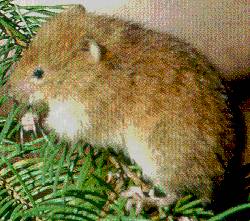Tree voles
| Tree voles | ||||||||||||
|---|---|---|---|---|---|---|---|---|---|---|---|---|

Red tree vole ( Arborimus longicaudus ) |
||||||||||||
| Systematics | ||||||||||||
|
||||||||||||
| Scientific name | ||||||||||||
| Arborimus | ||||||||||||
| Taylor , 1915 | ||||||||||||
The tree vole ( Arborimus ) are a genus of voles , for arboreal their lifestyle is name-giving. Although they have many characteristics that clearly differentiate them from other voles, they have long been considered a subgenus of the heather voles ( Phenacomys ). Even today there are still supporters of such a classification. Occasionally the tree vole are then distributed to two sub-genres, Arborimus and Paraphenacomys .
Tree voles have a head body length of 10 to 11 cm, with an additional 6 to 8 cm tail. They are dark brown (white-footed vole) or red-brown (red tree vole) on top and white or gray on the underside. They share many features of their teeth with the related heather voles, but differ from them in that they have a much longer tail and smaller ears.
The habitat of the tree voles are coastal forests in the US states of Oregon and California . The way of life is to be described using the red tree vole of western Oregon, which of the species is best studied. It lives in close association with Douglas firs , spruces and other conifers . There is a noticeable difference between males and females: the males hide in the undergrowth of the forest and dig a burrow in the ground. The females, however, are pure tree dwellers who build a nest at a height of 5 to 15 m. This nest is made of twigs and needles that are placed in a fork of branches or on an abandoned bird's nest. It has a diameter of 25 to 30 cm. To mate, the ground-dwelling males climb a tree and build a smaller nest, which they only inhabit until they have found a female. After mating, they return to the ground. After a gestation period of 28 days, the female gives birth to one to three young who are suckled for 30 days. The gestation and suckling periods are relatively long for voles. Growth is also quite slow. The reason for this could be the low nutritional value of the conifer needles, which are almost the sole food source of the red tree vole. Here it is mainly Douglas fir needles that are eaten, while the needles of other trees make up a far smaller proportion; If you take this food from a tree vole and try to supply it with other food, it dies quickly.
Tree voles have an atypical slow locomotion for mice. They move very carefully in the branches and try to get a firm hold before taking the next step.
There are three types:
- Red tree vole , Arborimus longicaudus , western Oregon
- White-footed vole , Arborimus albipes , western Oregon, northwestern California
- Sonoma tree vole , Arborimus pomo , northwest. California
The white-footed vole has the largest range, but is much rarer than the red tree vole. In contrast to the red tree vole, it is more tied to deciduous trees . The Sonoma tree vole resembles the red tree vole in its way of life and is even rarer.
literature
- Ronald M. Nowak: Walker's Mammals of the World. 2 volumes. 6th edition. Johns Hopkins University Press, Baltimore MD et al. 1999, ISBN 0-8018-5789-9 .